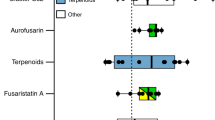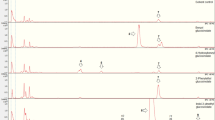Abstract
Organisms that produce hydrogen cyanide gas to protect themselves against predators can do so by the enzymatic breakdown of a class of compounds known as cyanogens (such as cyanogenic glycosides)1,2. Here we show how a neotropical butterfly, Heliconius sara, can avoid the harmful effects of the cyanogenic leaves of Passiflora auriculata (passion vine), on which its larvae feed exclusively. To our knowledge this is the first example of an insect that is able to metabolize cyanogens and thereby prevent the release of cyanide. The mechanistic details of this pathway might suggest new ways to make cyanogenic crops more useful as a food source.
This is a preview of subscription content, access via your institution
Access options
Subscribe to this journal
Receive 51 print issues and online access
$199.00 per year
only $3.90 per issue
Buy this article
- Purchase on Springer Link
- Instant access to full article PDF
Prices may be subject to local taxes which are calculated during checkout

Similar content being viewed by others
References
Spencer, K. C. in Chemical Mediation of Coevolution (ed. Spencer, K. C.) 167–240 (Academic, New York, 1988).
Jones, D. A. Phytochemistry 47 (suppl. 2), 155–162 (1998).
Gilbert, L. E. Sci. Am. 247, 110–121 (1982).
Jaroszewski, J. W., Andersen, J. V. & Billeskov, I. Tetrahedron 43, 2349–2354 (1987).
Seigler, D. S. & Brinker, A. M. in Methods in Plant Biochemistry vol. 8 (ed. Waterman, P. G.) 51–131 (Academic, New York, 1993).
Nahrstedt, A. & Davis, R. H. Comp. Biochem. Physiol. 75B, 65–73 (1983).
Raubenheimer, D. J. Chem. Ecol. 15, 2177–2189 (1989).
Chamberlain, P. & MacKenzie, R. M. in Cyanide in Biology (eds Vennesland, B., Conn, E. E., Knowles, C. J., Westley, J. & Wissing, F.) 184–196 (Academic, New York, 1981).
Conn, E. E. in Cyanide in Biology (eds Vennesland, B., Conn, E. E., Knowles, C. J., Westley, J. & Wissing, F.) 335–348 (Academic, New York, 1981).
Adsersen, A., Brimer, L., Olsen, C. E. & Jaroszewski, J. W. Phytochemistry 33, 365–367 (1993).
Author information
Authors and Affiliations
Corresponding author
Rights and permissions
About this article
Cite this article
Engler, H., Spencer, K. & Gilbert, L. Preventing cyanide release from leaves. Nature 406, 144–145 (2000). https://doi.org/10.1038/35018159
Issue Date:
DOI: https://doi.org/10.1038/35018159
This article is cited by
-
Assessing the Role of Developmental and Environmental Factors in Chemical Defence Variation in Heliconiini Butterflies
Journal of Chemical Ecology (2021)
-
Deletion of biosynthetic genes, specific SNP patterns and differences in transcript accumulation cause variation in hydroxynitrile glucoside content in barley cultivars
Scientific Reports (2019)
-
Evolution of the Biosynthetic Pathway for Cyanogenic Glucosides in Lepidoptera
Journal of Molecular Evolution (2018)
-
Mechanism of Resistance to Camptothecin, a Cytotoxic Plant Secondary Metabolite, by Lymantria sp. Larvae
Journal of Chemical Ecology (2018)
Comments
By submitting a comment you agree to abide by our Terms and Community Guidelines. If you find something abusive or that does not comply with our terms or guidelines please flag it as inappropriate.



